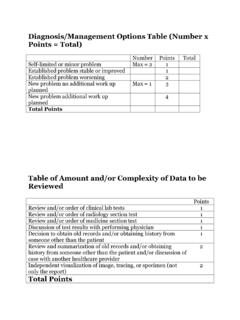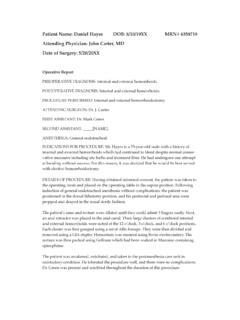Transcription of E/M LEVEL WORKSHEET
1 E/M LEVEL WORKSHEET . STEP 1 : IDENTIFY THE CATEGORY AND SUBCATEGORY OF SERVICE. Carefully read the documentation. Using the Table of Contents, identify the appropriate category/subcategory. Category Subcategory (if applicable) (new/established, etc.). STEP 2: REVIEW THE REPORTING INSTRUCTIONS FOR THE SELECTED CATEGORY OR SUBCATEGORY. Read the section -specific instructions for the selected category/subcategory. STEP 3: REVIEW THE LEVEL OF E/M SERVICE DESCRIPTORS (HISTORY, EXAM, MEDICAL DECISION. MAKING, COUNSELING, COORDINATION OF CARE, NATURE OF PRESENTING PROBLEM AND TIME). Read the E/M service descriptors (history, exam, medical decision making, counseling, coordination of care, nature of presenting problem and time). STEP 4: DETERMINE THE EXTENT OF HISTORY OBTAINED.
2 A. Identify the Chief Complaint: b. Evaluate the HPI for the following elements: location (anatomical place, position or site of the chief complaint). severity (a degree or measurement of the severity). timing (when or at what frequency the problem is noticed). modifying factors (anything that makes the problem better or worse). quality (a problem's characteristics, such as how it looks or feels). duration (description of approx. duration of symptoms). context (description of how symptoms began). associated signs and symptoms (significant signs or symptoms patient feels are related to injury/illness or a lack thereof). HPI contains three or more chronic problems Total elements In addition to using the above elements, the LEVEL of the HPI can be based on the physician's documentation of the status of 3 or more of chronic problems.
3 If the physician documents the status of 3 of more chronic problems the HPI would be counted as extended. Number of chronic problems referenced brief extended (1-3 brief, 4 or more extended, 3 or more chronic problems extended). c. Analyze Review of Systems Constitutional (weight loss, fever, chills, malaise). Ear, nose, throat, and mouth (hearing loss, sinusitis, sore throat, oral cavities, ulcers). Gastrointestinal (nausea, vomiting, diarrhea, constipation, ulcer ). integumentary (skin rashes, moles, dryness, lumps, pigmentation). Endocrine (polyuria, polydypsia, cold-heat intolerance, diabetes). Genitourinary (hematuria, nocturia, menopause, hernia). Hematologic/lymphatic (anemia, bruising, bleeding, lymph node enlargement). Eyes (diplopia, blurred vision).
4 Cardiovascular (chest pain or pressure , palpitations, murmur, hypertension). Musculoskeletal (arthritis, joint stiffness, swelling, myalgias, gout). Neurologic (dizziness, syncope, vertigo, weakness, tremor). Allergic/immunologic (allergies to medicine, food, dye; hepatitis; HIV). Respiratory (cough, hemoptysis, pleuritic chest pain, wheezing, asthma). Psychiatric (depression, agitation, panic-anxiety, memory disturbance). Total body systems covered Determine extent of ROS: None (no problem pertinent ROS/no ROS). Problem pertinent (problem pertinent ROS, one system). Extended (problem pertinent ROS w/limited additional systems (problem pertinent + at least one additional body system, up to nine). Complete (problem pertinent + all additional (minimum of 10) body systems).)
5 Analyze PFSH: Past medical history: Adult and childhood illnesses or trauma, vaccinations and screenings, past surgical history, and past and present medications Family history: Describes parents, siblings, children, genetic diseases of family or other family history Social history: Information about the patient's habits and circumstances (smoking, alcohol consumption, drug use, sexual orientation, marital status, place of birth, residence, occupation, education LEVEL , religion, recent travel destinations). Determine extent of PFSH. None = No documented past, family, and/or social history Pertinent = Documentation of at least one item from any of the three history areas. Complete = Documentation of at least one item from two of three history areas or three of three history areas depending on E/M code type.
6 KEY COMPONENT: Extent of History Obtained: Problem focused (CC, brief HPI). Expanded problem focused (CC, brief HPI w/problem pertinent ROS). Detailed (CC, extended HPI w/extended ROS (1-9 add'l body systems), pertinent PFSH). Comprehensive (CC, extended HPI w/complete ROS (10+ body systems), complete PFSH. STEP 5: DETERMINE THE EXTENT OF EXAMINATION PERFORMED USING THE ELEMENTS OF EXAMINA- TION REFERENCE SHEET. Identify body areas covered (check) and count elements: Chest, including breasts and axillae Elements: Neck trachea-larynx, thyroid Elements: Identify organ systems covered (check) and count elements: Constitutional Elements Eyes Elements Ears, nose, throat Elements Cardiovascular Elements Respiratory Elements Gastrointestinal Elements Genitourinary Elements Musculoskeletal Elements Skin Elements Neurological Elements Psychiatric Elements Lymphatic Elements Count elements and use Determining Extent of Examination Performed reference sheet to assign LEVEL of Exam.)
7 KEY COMPONENT: Extent of Examination Obtained: None Problem focused (one to five elements identified by a bullet). Expanded problem focused (at least six elements identified by a bullet). Detailed (at least two elements identified by a bullet from each of six areas/systems or at least twelve ele- ments identified by a bullet in two or more areas/systems). Comprehensive (all elements in nine body areas/organ systems. For each area/system, documentation of at least two elements identified by a bullet is expected). STEP 6: DETERMINE THE COMPLEXITY OF MEDICAL DECISION MAKING. Identify and classify problem as self-limited, minor, established stable or improved, or established worsening. If problem is new, determine if additional workup is planned.
8 Use the DMO Table to determine points. DIAGNOSIS/MGMT OPTIONS TABLE (NUMBER X POINTS = TOTAL. NUMBER POINTS TOTAL. Self-limited or minor problem 1. Established problem (to provider) stable or improved 1. Extablished problem (to provider) worsening 2. New problem (to provider) no additional work up planned 3. New problem (to provider) additional work up planned 4. Total Points Max number of self-limited or minor problems = 2. Max number of new problem no additional work planned = 1. Assign Diagnosis/Mgmt Options LEVEL : 1 point = Straightforward 2 points = Low 3 points = Moderate 4+ points = High Identify Data to be Reviewed elements in the medical record. TABLE OF AMOUNT AND/OR COMPLEXITY OF DATA TO BE REVIEWED. POINTS. Review and/or order of clinical lab tests 1.)
9 Review and/or order of radiology section test 1. Review and/or order of medicine section test 1. Discussion of test results with performing physician 1. Decision to obtain old records and/or obtaining history from someone other than the patient 1. Review and summarization of old records and/or obtaining history from someone other than the patient and/ 2. or discussion of case with another healthcare provider Independent visualization of image, tracing, or specimen (not only the report) 2. Total Points Assign Amount and/or Complexity of Data LEVEL : 0-1 point = Straightforward 2 points = Low 3 points = Moderate 4+ points = High Table of Risk Presenting Problem Straightforward Low Moderate High Diagnostic Procedures Ordered Straightforward Low Moderate High Management Options Selected Straightforward Low Moderate High Assign the LEVEL of Risk (highest of presenting problem, diagnostic procedures ordered, and management options selected): Straightforward Low Moderate High Diagnosis/Mgmt Options, Amount and/or Complexity of Data to be Reviewed, and LEVEL of Risk are analyzed to determine extent of MDM obtained (2 out of 3 must be met or exceeded).
10 KEY COMPONENT: Extent of MDM Obtained: Straightforward medical decision making Medical decision making of low complexity Medical decision making of moderate complexity Medical decision making of high complexity STEP 7: SELECT THE APPROPRIATE LEVEL OF E/M SERVICES. Career Step, LLC. 2013. All Rights Reserved.










